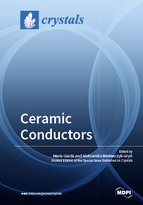Ceramic Conductors
A special issue of Crystals (ISSN 2073-4352). This special issue belongs to the section "Inorganic Crystalline Materials".
Deadline for manuscript submissions: closed (31 October 2018) | Viewed by 44897
Special Issue Editors
Interests: proton conducting ceramics; mixed electron-ion conductrs; perovskites; high-temperature superconductors; X-ray diffraction
Interests: proton conducting ceramics; mixed electron-ion conductrs; RE niobates; defect chemistry; thermal analysis
Special Issues, Collections and Topics in MDPI journals
Special Issue Information
Dear Colleagues,
Ceramics is traditionally considered as electrically insulating; however, several groups of modern advanced ceramics are conductors of electric current. Among them, there are high-temperature superconductors, metal-like conducting ceramics, semiconductors, as well as ionically conducting ceramics. The electric and electrochemical properties of conducting ceramics, apart from chemical composition, may depend strongly on their micro/nanostructure, porosity, defect interaction, redox processes, atmosphere composition, etc. Therefore, their properties may be modified through both the powder fabrication and its densification and shaping into products. Moreover, many ceramic materials undergo structural phase transitions. The variety of phenomena related to charge transport in ceramics render them very interesting for practical applications. Indeed, conducting ceramics has been applied in superconducting electromagnets, gas sensors, solid oxide fuel cells, batteries, varistors, memory cells, and other electroceramic devices.
The Special Issue on “Conducting Ceramics” is intended to provide a unique interdisciplinary international forum aimed at presenting and discussion of results concerning fabrication, characterization and properties of conducting ceramics as well as characterization of devices based on conducting ceramics. Scientists working in a wide range of disciplines are invited to contribute to this issue.
Examples of the topics which may be included in the Special Issue on “Conducting Ceramics” are listed under the keywords.
Prof. Dr. Maria Gazda
Dr. Aleksandra Mielewczyk-Gryń
Guest Editors
Manuscript Submission Information
Manuscripts should be submitted online at www.mdpi.com by registering and logging in to this website. Once you are registered, click here to go to the submission form. Manuscripts can be submitted until the deadline. All submissions that pass pre-check are peer-reviewed. Accepted papers will be published continuously in the journal (as soon as accepted) and will be listed together on the special issue website. Research articles, review articles as well as short communications are invited. For planned papers, a title and short abstract (about 100 words) can be sent to the Editorial Office for announcement on this website.
Submitted manuscripts should not have been published previously, nor be under consideration for publication elsewhere (except conference proceedings papers). All manuscripts are thoroughly refereed through a single-blind peer-review process. A guide for authors and other relevant information for submission of manuscripts is available on the Instructions for Authors page. Crystals is an international peer-reviewed open access monthly journal published by MDPI.
Please visit the Instructions for Authors page before submitting a manuscript. The Article Processing Charge (APC) for publication in this open access journal is 2600 CHF (Swiss Francs). Submitted papers should be well formatted and use good English. Authors may use MDPI's English editing service prior to publication or during author revisions.
Keywords
- Electronic conductivity and superconductivity of ceramics
- Ionic ceramic conductors
- Mixed ceramic conductors
- Fabrication and shaping of conducting ceramics
- Electroceramic devices






